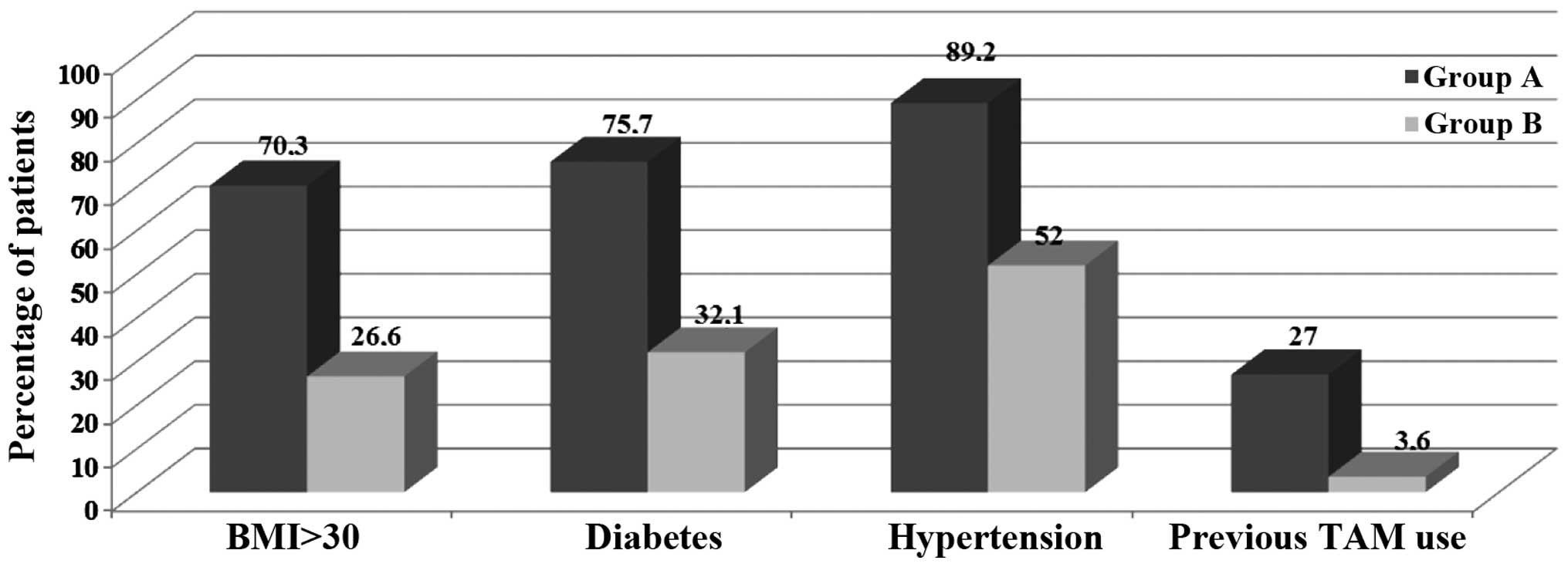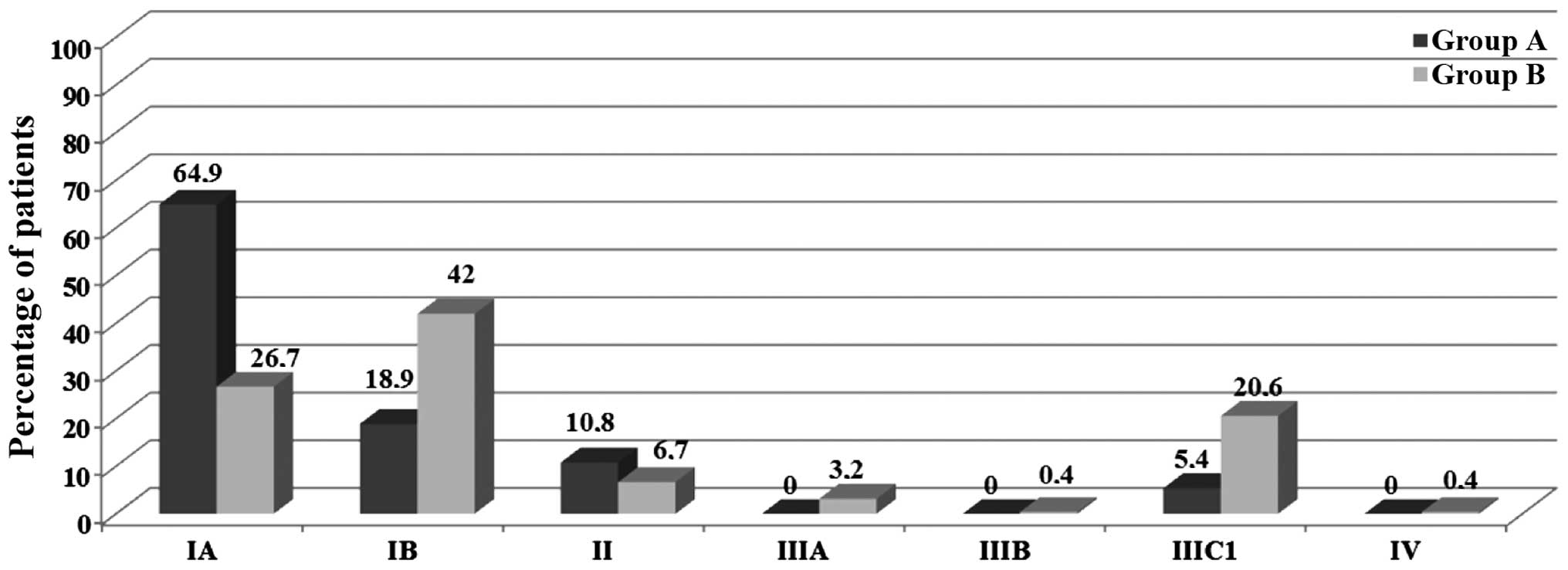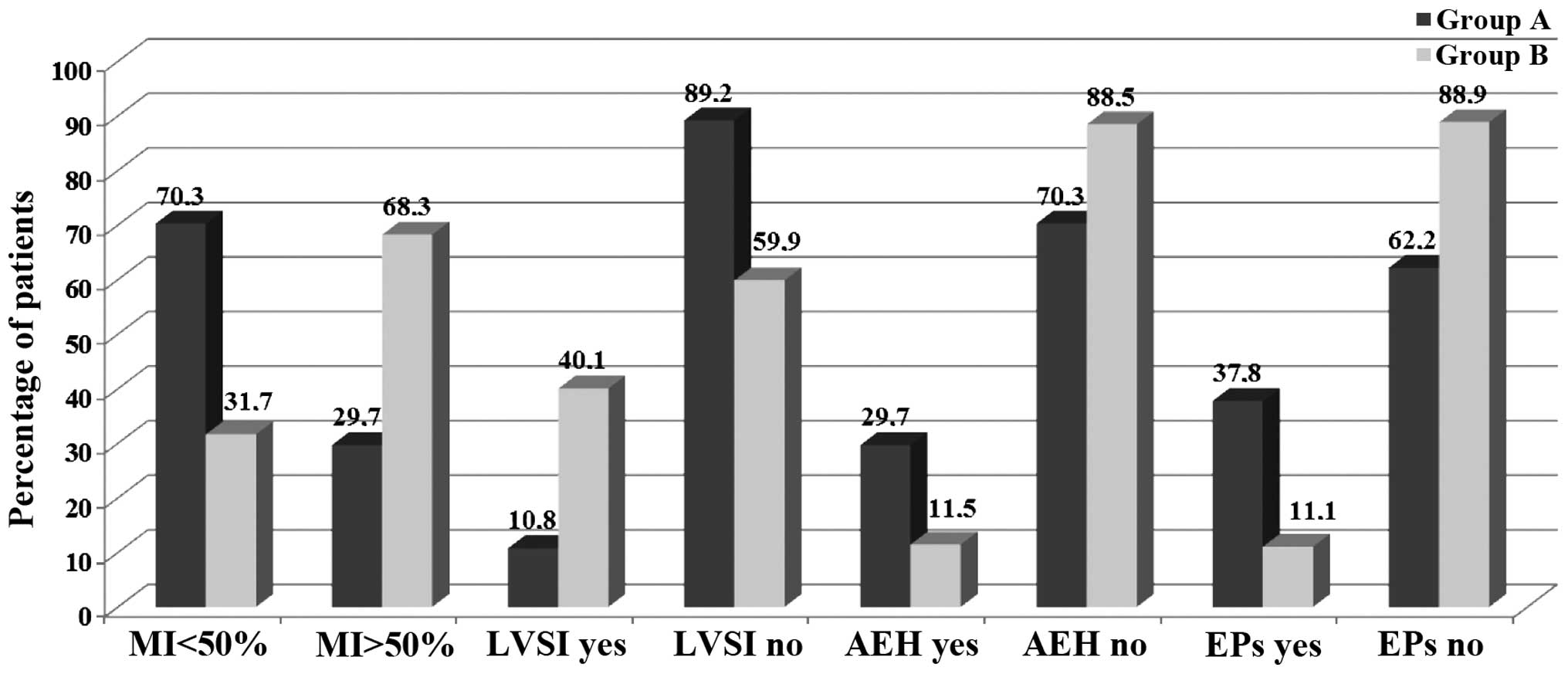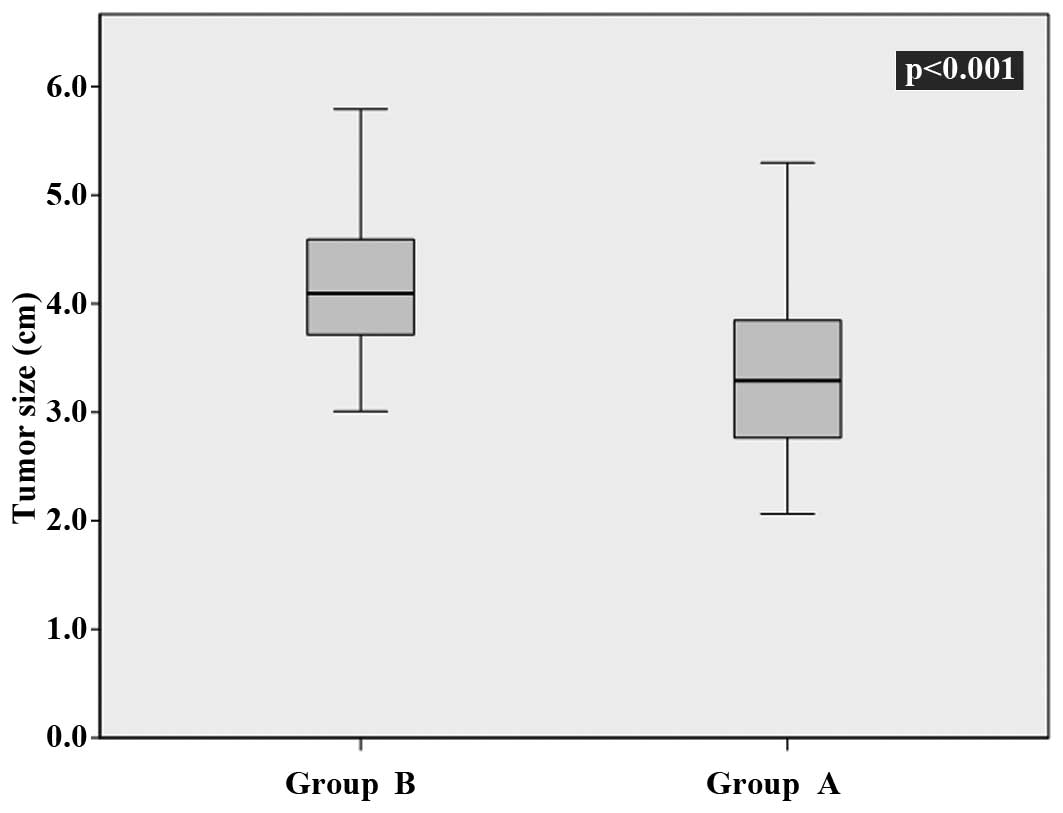|
1
|
Siegel RL, Miller KD and Jemal A: Cancer
statistics, 2015. CA Cancer J Clin. 65:5–29. 2015. View Article : Google Scholar : PubMed/NCBI
|
|
2
|
Prat J: Prognostic parameters of
endometrial carcinoma. Hum Pathol. 35:649–462. 2004. View Article : Google Scholar : PubMed/NCBI
|
|
3
|
Giordano G, D'Adda T, Bottarelli L,
Lombardi M, Brigati F, Berretta R and Merisio C: Two cases of
low-grade endometriod carcinoma associated with undifferentiated
carcinoma of the uterus (dedifferentiated carcinoma): A molecular
study. Pathol Oncol Res. 18:523–528. 2012. View Article : Google Scholar : PubMed/NCBI
|
|
4
|
Musa F, Frey MK, Im HB, Chekmareva M,
Ellenson LH and Holcomb K: Does the presence of adenomyosis and
lymphovascular space invasion affect lymph node status in patients
with endometrioid adenocarcinoma of the endometrium? Am J Obstet
Gynecol. 207:417e1–e6. 2012. View Article : Google Scholar
|
|
5
|
Pecorelli S: Revised FIGO staging for
carcinoma of the vulva cervix and endometrium. Int J Gynaecol
Obstet. 105:103–104. 2009. View Article : Google Scholar : PubMed/NCBI
|
|
6
|
Hanley KZ, Dustin SM, Stoler MH and Atkins
KA: The significance of tumor involved adenomyosis in otherwise
low-stage endometrioid adenocarcinoma. Int J Gynecol Pathol.
29:445–451. 2010. View Article : Google Scholar : PubMed/NCBI
|
|
7
|
Garcia L and Isaacson K: Adenomyosis:
Review of the literature. J Minim Invasive Gynecol. 18:428–437.
2011. View Article : Google Scholar : PubMed/NCBI
|
|
8
|
Bergeron C, Amant F and Ferenczy A:
Pathology and physiopathology of adenomyosis. Best Pract Res Clin
Obstet Gynaecol. 20:511–21. 2006. View Article : Google Scholar : PubMed/NCBI
|
|
9
|
Mittal KR and Barwick KW: Endometrial
adenocarcinoma involving adenomyosis without true myometrial
invasion is characterized by frequent preceding estrogen therapy
low histologic grades and excellent prognosis. Gynecol Oncol.
49:197–201. 1993. View Article : Google Scholar : PubMed/NCBI
|
|
10
|
Jacques SM and Lawrence WD: Endometrial
adenocarcinoma with variable-level myometrial involvement limited
to adenomyosis: A clinicopathologic study of 23 cases. Gynecol
Oncol. 37:401–407. 1990. View Article : Google Scholar : PubMed/NCBI
|
|
11
|
Hernandez E and Woodruff JD: Endometrial
adenocarcinoma arising in adenomyosis. Am J Obstet Gynecol.
138:827–832. 1980.PubMed/NCBI
|
|
12
|
Kucera E, Hejda V, Dankovcik R, Valha P,
Dudas M and Feyereisl J: Malignant changes in adenomyosis in
patients with endometrioid adenocarcinoma. Eur J Gynaecol Oncol.
32:182–184. 2011.PubMed/NCBI
|
|
13
|
Ismiil N, Rasty G, Ghorab Z, Nofech-Mozes
S, Bernardini M, Ackerman I, Thomas G, Covens A and Khalifa MA:
Adenomyosis involved by endometrial adenocarcinoma is a significant
risk factor for deep myometrial invasion. Ann Diagn Pathol.
11:252–257. 2007. View Article : Google Scholar : PubMed/NCBI
|
|
14
|
Seidman JD and Kjerulff KH: Pathologic
findings from the Maryland women's health study: Practice patterns
in the diagnosis of adenomyosis. Int J Gynecol Pathol. 15:217–221.
1996. View Article : Google Scholar : PubMed/NCBI
|
|
15
|
Ismiil ND, Rasty G, Ghorab Z, Nofech-Mozes
S, Bernardini M, Thomas G, Ackerman I, Covens A and Khalifa MA:
Adenomyosis is associated with myometrial invasion by FIGO 1
endometrial adenocarcinoma. Int J Gynecol Pathol. 26:278–283. 2007.
View Article : Google Scholar : PubMed/NCBI
|
|
16
|
Saccardi C, Gizzo S, Ludwig K, Guido M,
Scarton M, Gangemi M, Tinelli R and Litta PS: Endometrial polyps in
women affected by levothyroxine-treated hypothyroidism -
histological features, immunohistochemical findings and possible
explanation of etiopathogenic mechanism, A pilot study. Biomed Res
Int. 2013:5034192013. View Article : Google Scholar : PubMed/NCBI
|
|
17
|
Gizzo S, Saccardi C, Patrelli TS, et al:
Update on raloxifene: Mechanism of action, clinical efficacy,
adverse effects and contraindications. Obstet Gynecol Surv.
68:467–481. 2013. View Article : Google Scholar : PubMed/NCBI
|
|
18
|
Saccardi C, Conte L, Fabris A, et al:
Hysteroscopic enucleation in toto of submucous type 2 myomas:
Long-term follow-up in women affected by menorrhagia. J Minim
Invasive Gynecol. 21:426–430. 2014. View Article : Google Scholar : PubMed/NCBI
|
|
19
|
Gizzo S, Di Gangi S, Bertocco A, Noventa
M, Fagherazzi S, Ancona E, Saccardi C, Patrelli TS, D'Antona D and
Nardelli GB: Levonorgestrel intrauterine system in adjuvant
tamoxifen treatment, Balance of breast risks and endometrial
benefits - systematic review of literature. Reprod Sci. 21:423–431.
2014. View Article : Google Scholar : PubMed/NCBI
|
|
20
|
Saccardi C, Gizzo S, Patrelli TS, Ancona
E, Anis O, Di Gangi S, Vacilotto A, D'Antona D and Nardelli GB:
Endometrial surveillance in tamoxifen users: Role, timing and
accuracy of hysteroscopic investigation, Observational longitudinal
cohort study. Endocr Relat Cancer. 20:455–462. 2013. View Article : Google Scholar : PubMed/NCBI
|
|
21
|
Rosai J: Female reproductive system. Rosai
and Ackerman's Surgical Pathology. 2:(10th). Mosby Elsevier.
1399–1422. 2011.
|
|
22
|
Kurman RJ, Ellenson LH and Ronnett BM:
Blaustein's Pathology of the Female Genital Tract (6th). New York:
Springer. 2011. View Article : Google Scholar
|
|
23
|
Wright JD, Medel Barrena NI, Sehouli J,
Fujiwara K and Herzog TJ: Contemporary management of endometrial
cancer. Lancet. 379:1352–1360. 2012. View Article : Google Scholar : PubMed/NCBI
|
|
24
|
Berretta R, Patrelli TS, Faioli R, Mautone
D, Gizzo S, Mezzogiorno A, Giordano G and Modena AB:
Dedifferentiated endometrial cancer: An atypical case diagnosed
from cerebellar and adrenal metastasis, Case presentation and
review of literature. Int J Clin Exp Pathol. 6:1652–1657.
2013.PubMed/NCBI
|
|
25
|
Gizzo S, Fabris A, Litta P and Saccardi C:
Estimated intermediate risk endometrial cancer, Debate and new
perspectives on therapy individualization and prognosis
establishment starting from a peculiar case. Int J Clin Exp Pathol.
7:2664–2669. 2014.PubMed/NCBI
|
|
26
|
Berretta R, Patrelli TS, Migliavacca C,
Rolla M, Franchi L, Monica M, Modena AB and Gizzo S: Assessment of
tumor size as a useful marker for the surgical staging of
endometrial cancer. Oncol Rep. 31:2407–2412. 2014.PubMed/NCBI
|
|
27
|
Chrysostomou M, Akalestos G, Kallistros S,
Papadimitriou V, Nazar S and Chronis G: Incidence of adenomyosis
uteri in a Greek population. Acta Obstet Gynecol Scand. 70:441–444.
1991. View Article : Google Scholar : PubMed/NCBI
|
|
28
|
Gün I, Oner O, Bodur S, Ozdamar O and Atay
V: Is adenomyosis associated with the risk of endometrial cancer?
Med Glas (Zenica). 9:268–272. 2012.PubMed/NCBI
|
|
29
|
Ueki K, Kumagai K, Yamashita H, Li ZL,
Ueki M and Otsuki Y: Expression of apoptosis-related proteins in
adenomyotic uteri treated with danazol and GnRH agonists. Int J
Gynecol Pathol. 23:248–258. 2004. View Article : Google Scholar : PubMed/NCBI
|
|
30
|
Merisio C, Berretta R, De Ioris A,
Pultrone DC, Rolla M, Giordano G, Tateo S and Melpignano M:
Endometrial cancer in patients with preoperative diagnosis of
atypical endometrial hyperplasia. Eur J Obstet Gynecol Reprod Biol.
122:107–111. 2005. View Article : Google Scholar : PubMed/NCBI
|
|
31
|
Kim YB and Niloff JM: Endometrial
carcinoma: Analysis of recurrence in patients treated with a
strategy minimizing lymph node sampling and radiation therapy.
Obstet Gynecol. 82:175–180. 1993.PubMed/NCBI
|
|
32
|
Todo Y, Kato H, Kaneuchi M, Watari H,
Takeda M and Sakuragi N: Survival effect of para-aortic
lymphadenectomy in endometrial cancer (SEPAL study): A
retrospective cohort analysis. Lancet. 375:1165–1172. 2010.
View Article : Google Scholar : PubMed/NCBI
|
|
33
|
Patrelli TS, Berretta R, Rolla M, Vandi F,
Capobianco G and Gramellini D: BacchiM odena A and Nardelli GB:
Pelvic lymphadenectomy in endometrial cancer: Our current
experience. Eur J Gynaecol Oncol. 30:536–538. 2009.PubMed/NCBI
|
|
34
|
Mariani A, Webb MJ, Keeney GL and Podratz
KC: Routes of lymphatic spread, A study of 112 consecutive patients
with endometrial cancer. Gynecol Oncol. 81:100–104. 2001.
View Article : Google Scholar : PubMed/NCBI
|
|
35
|
Schink JC, Rademaker AW, Miller DS and
Lurain JR: Tumor size in endometrial cancer. Cancer. 67:2791–2794.
1991. View Article : Google Scholar : PubMed/NCBI
|
|
36
|
Boes AS, Tousseyn T, Vandenput I,
Timmerman D, Vergote I, Moerman P and Amant F: Pitfall in the
diagnosis of endometrial cancer, Case report of an endometrioid
adenocarcinoma arising from uterine adenomyosis. Eur J Gynaecol
Oncol. 32:431–434. 2011.PubMed/NCBI
|
|
37
|
Berretta R, Merisio C, Piantelli G, Rolla
M, Giordano G, Melpignano M and Nardelli GB: Preoperative
transvaginal ultrasonography and intraoperative gross examination
for assessing myometrial invasion by endometrial cancer. J
Ultrasound Med. 27:349–355. 2008.PubMed/NCBI
|
|
38
|
Savelli L, Ceccarini M, Ludovisi M,
Fruscella E, De Iaco PA, Salizzoni E, Mabrouk M, Manfredi R, Testa
AC and Ferrandina G: Preoperative local staging of endometrial
cancer, Transvaginal sonography vs. Histopathology. Ultrasound
Obstet Gynecol. 31:560–566. 2008. View
Article : Google Scholar : PubMed/NCBI
|
|
39
|
Gizzo S, Ancona E, Saccardi C, D'Antona D,
Nardelli GB and Plebani M: Could kidney glomerular filtration
impairment represent the ‘Achilles heel’ of HE4 serum marker? A
possible further implication. Clin Chem Lab Med. 52:e45–e46. 2014.
View Article : Google Scholar : PubMed/NCBI
|













